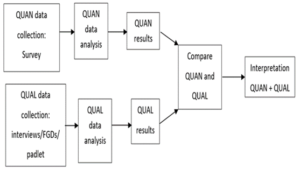By Saraswati Dawadi
In this project we are using a mixed-methods approach, adopting a time series longitudinal design to collect data from undergraduate students (enrolled in four disciplines, namely Business/Economics, Humanities, Sciences, and Medicine/Nursing), teachers and other key stakeholders including educationists, policy makers and representatives from I/NGOs who work in education and IT companies in the four research countries. We are collecting data by using several methods of quantitative and qualitative research in two phases, with a 13–15-month interval between the two. The quantitative part is online surveys for students and teachers, and the qualitative part consists of focus group discussions (FGDs), semi- structured interviews and Padlet discussions.

The use of a mixed-method design offers us methodological flexibility and should lead to an in-depth understanding of the research issues. Using data from multiple sources in two phases, we will be able to address our research questions with appropriate depth and breadth (Dawadi et al. 2021). The quantitative method (i.e., online questionnaire surveys) enables us to collect data from a large number of participants, increasing the possibility of generalising our findings to a wider population, while the qualitative methods (interviews, FGDs and Padlet discussion) will provide a deeper understanding of the research issues being explored, honouring the voices of our participants. This approach enables us to develop more effective and refined conclusions by using data from multiple sources (Plano Clark & Ivankova, 2016).
 There are four justifications for combining qualitative and quantitative data in this study: triangulation (seeking corroboration between the two sets of data), expansion (extending the breadth and range of enquiry by using different methods), complementarity (elaboration, illustration and explanation of the results from one method with the results from another), and convergent findings (using both data sets to answer the same research question and producing greater certainty in the conclusion)
There are four justifications for combining qualitative and quantitative data in this study: triangulation (seeking corroboration between the two sets of data), expansion (extending the breadth and range of enquiry by using different methods), complementarity (elaboration, illustration and explanation of the results from one method with the results from another), and convergent findings (using both data sets to answer the same research question and producing greater certainty in the conclusion)
As the main purpose of using a mixed methods design in this study is to obtain different but complementary data on the same research issues in order to understand them better, the data are collected separately, but independently from each other, and combined before interpreting the findings. Equal priority is given to both data sets, giving equal importance of both types of data in answering the research questions in this study. Quantitative results are triangulated with qualitative findings and vice versa to produce rigorous and reliable findings.
However, we have faced some challenges in using this design. First, in a complex project involving four countries it requires a large amount of time, effort and planning. Secondly, it requires us to have a wider set of skills to conduct the research rigorously as it involves data collection and analysis from multiple sources in multiple phases. One more challenge for us is to suitably combine different methods and/or datasets so that there is no compromise on the reliability and robustness of the research. The research methods and tools used in this study have been piloted in all four countries, which has been an essential step but has entailed more time, effort and planning.
An additional challenge was related to instrument design (particularly the online questionnaires) for the study. Since we are collecting data from four different countries and our participants (students and teachers) are from four different disciplines, it was difficult to make our instruments suitable for all the participants. Similarly, we wanted to collect information about participants’ ethnic backgrounds, but we realised that any classification used in the UK would not be applicable in the four research contexts, particularly because people in those countries are often from mixed backgrounds. One more challenge for us was to define key terms such as equality, diversity and inclusion, as we found that these terms are not necessarily widely understood, or understood in the same way, but we had limited space to define them in our questionnaires. However, we will get an opportunity to delve into the issues further when we conduct interviews, FGDs and Padlet discussions.
References:
Dawadi, S., Shrestha S., & Giri, R.A. (2021). Mixed-methods research: A discussion on its types, challenges, and criticisms. Journal of Practical Studies in Education, 2(2), 25-36.
Plano Clark, V. L. & Ivankova, N. V. (2016). Mixed methods research. A guide to the field. Sage Publications
